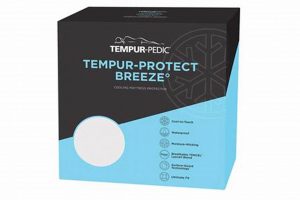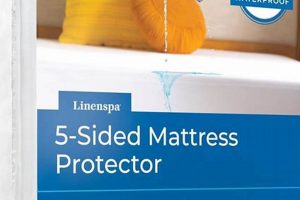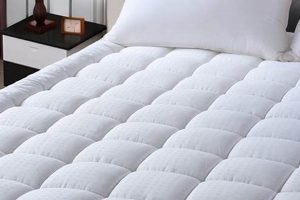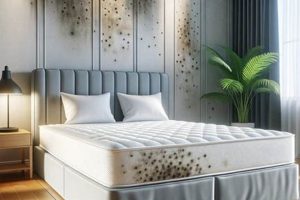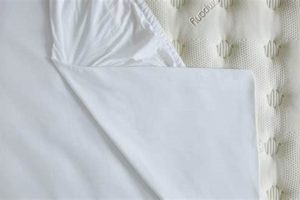The effectiveness of encasing a mattress to deter bed bug infestations is a common inquiry. These protective covers function as a barrier, physically separating the mattress from potential pests. This method aims to deny bed bugs access to their preferred harborage and feeding grounds within the mattress itself.
Utilizing such encasements offers several advantages. By preventing bed bugs from establishing residence within the mattress, the covers simplify detection and eradication efforts. Furthermore, they safeguard the mattress from stains, allergens, and other contaminants, extending its lifespan and maintaining a cleaner sleep environment. Historically, mattress encasements were primarily used for allergy control, but their role in bed bug prevention has gained prominence with the resurgence of these pests.
The subsequent sections will delve into the specific features required for effective bed bug protection, proper installation techniques, and the limitations of relying solely on mattress encasements for complete bed bug control. This will involve exploring factors such as zipper quality, seam construction, and the need for integrated pest management strategies.
Protective Mattress Encasement Guidance
The following guidelines address maximizing the effectiveness of mattress encasements in the context of potential or existing bed bug infestations. Implementation of these measures can contribute to a more secure sleep environment.
Tip 1: Select Certified Encasements: Prioritize products explicitly labeled as “bed bug proof” or “bed bug certified.” These have undergone testing to ensure their zippers and seams are impenetrable to these pests.
Tip 2: Inspect Zipper Quality: A secure zipper closure is paramount. Opt for encasements featuring fine-toothed zippers with a locking mechanism or Velcro flap to prevent bed bug egress or ingress.
Tip 3: Examine Seam Construction: Seams should be meticulously sewn and reinforced. Inadequate seam construction compromises the barrier, rendering the encasement ineffective. Regularly inspect seams for any signs of wear or separation.
Tip 4: Properly Install and Seal the Encasement: Encase the mattress completely, ensuring all sides are covered. Seal the zipper closure thoroughly according to the manufacturer’s instructions. Any gaps or openings negate the protective function.
Tip 5: Regularly Inspect the Encasement: Conduct routine visual inspections of the encasement for tears, punctures, or compromised zippers. Address any damage promptly to maintain its integrity.
Tip 6: Extend Protection to Box Springs: To ensure comprehensive protection, consider encasing the box spring as well. Bed bugs can harbor in box springs, creating a persistent infestation source.
Tip 7: Combine with Integrated Pest Management: Encasements are a component of a broader strategy. Implement regular vacuuming, laundering of bedding, and professional pest control services if an infestation is suspected.
Implementing these guidelines will enhance the protective benefits of mattress encasements, contributing to a more secure and pest-free sleep environment. These steps are most effective when integrated into a comprehensive pest management approach.
The subsequent section will address potential drawbacks and limitations associated with relying exclusively on encasements, providing a more balanced perspective on bed bug prevention and control.
1. Physical Barrier
The primary mechanism by which a mattress protector aids in mitigating bed bug infestations lies in its function as a physical barrier. This barrier prevents bed bugs from accessing the interior of the mattress, a common harborage site due to its abundant crevices and proximity to a blood source. If the protector is intact and properly sealed, it denies bed bugs the opportunity to establish a population within the mattress fibers. Consequently, this isolation strategy contributes to easier detection, containment, and eventual eradication of an infestation. A real-world example involves situations where bed bugs are introduced into a hotel room via luggage; a mattress with a high-quality protector effectively limits the infestation’s spread by confining the pests to areas outside the mattress itself, such as the bed frame or surrounding furniture. Understanding this protective role highlights the practical significance of selecting a protector with durable materials and secure closure mechanisms.
The effectiveness of the physical barrier is directly correlated to the quality of the protector’s construction. Impermeable materials, tightly woven fabrics, and robust zippers are essential for preventing bed bug penetration. However, it is crucial to acknowledge that a protector primarily addresses the mattress as a potential harborage. Bed bugs are adept at finding alternative hiding places, including cracks in the bed frame, behind baseboards, and within nearby furniture. Therefore, while the protector safeguards the mattress, it does not eliminate the need for a comprehensive pest management strategy that targets all potential hiding spots. The practical application of this understanding involves combining the use of a mattress protector with regular inspections of the surrounding environment and, if necessary, professional pest control interventions.
In summary, the physical barrier provided by a mattress protector is a critical component of a proactive bed bug management plan. It contributes to preventing mattress infestations, facilitating early detection, and containing the spread of bed bugs within a sleeping environment. However, the challenges associated with bed bug eradication necessitate a holistic approach that extends beyond the mattress itself. Therefore, while a quality mattress protector significantly reduces the likelihood of a mattress infestation, it is not a standalone solution and must be integrated with other preventive and control measures for optimal effectiveness. This understanding is central to appreciating the protector’s role within the broader context of bed bug management.
2. Zipper Integrity
Zipper integrity constitutes a critical element in determining the overall effectiveness of a mattress protector against bed bug infestations. The zipper assembly serves as the final closure point, and its failure directly compromises the protective function of the entire encasement. Consequently, the selection and maintenance of a robust and functional zipper are paramount to preventing bed bugs from accessing the mattress.
- Material and Construction
The zipper’s material composition and construction method directly influence its resilience against wear and tear, as well as its ability to withstand the pressure exerted by a fully encased mattress. Zippers constructed from durable materials, such as metal or high-density nylon, are less susceptible to breakage or separation than those made from cheaper alternatives. Reinforced stitching and a tight weave of the zipper tape further enhance its structural integrity. For instance, a protector utilizing a low-quality zipper might develop gaps along the zipper line, providing bed bugs with entry points, effectively negating the protector’s purpose.
- Closure Mechanism and Locking Features
The type of closure mechanism employed by the zipper significantly impacts its ability to create a complete seal. Self-locking zippers, which prevent accidental opening, are preferable. Additional features, such as Velcro flaps covering the zipper line, provide an extra layer of protection against bed bug penetration. In practical terms, a zipper lacking a secure locking mechanism can inadvertently slide open, especially under the weight and movement of a sleeping individual. This creates an avenue for bed bugs to enter or exit the encasement, rendering it ineffective.
- Maintenance and Inspection Protocols
Regular maintenance and inspection of the zipper are crucial for identifying and addressing potential vulnerabilities. Lubricating the zipper with a silicone-based spray can prevent sticking and ensure smooth operation. Visual inspections should be conducted periodically to check for signs of damage, such as broken teeth, separated tape, or loose stitching. Early detection of these issues allows for timely repairs or replacement of the protector, preserving its functionality. A scenario where a damaged zipper remains unaddressed demonstrates the importance of vigilance; bed bugs may exploit even minor zipper flaws to establish an infestation within the mattress.
- Tightness of Zipper Teeth Closure
The tightness of the zipper teeth when closed is critical to preventing bed bugs from entering or escaping the mattress encasement. If the teeth do not create a complete and secure seal, small gaps may exist, allowing bed bugs to penetrate the barrier. A zipper with tightly interlocking teeth ensures a more effective barrier against these pests. It is essential to examine the zipper closely after closure to verify that there are no visible openings or areas where the teeth are not properly aligned. This diligence helps maintain the integrity of the protector and its ability to prevent bed bug infestations.
In conclusion, zipper integrity is not merely a superficial feature but a fundamental aspect of the protective capability offered by a mattress encasement against bed bugs. A substandard zipper undermines the entire system, regardless of the quality of the surrounding fabric. Therefore, careful consideration of zipper material, construction, closure mechanism, and ongoing maintenance protocols is essential when selecting and utilizing a mattress protector for bed bug prevention.
3. Seam Construction
Seam construction represents a critical, yet often overlooked, element in determining whether a mattress protector effectively prevents bed bug infestations. The integrity of the seams dictates the overall protective capability, as any compromise can serve as an entry point for these pests.
- Stitch Density and Type
High stitch density, measured in stitches per inch, directly correlates with seam strength and resistance to bed bug penetration. Tight, interwoven stitches using durable threads, such as polyester or nylon, create a formidable barrier. Conversely, loosely stitched seams or those using weaker threads are more susceptible to separation under stress, providing gaps for bed bugs to exploit. For example, a protector with double-stitched, reinforced seams is far more likely to withstand the pressure of movement and maintain its integrity than one with single-stitched seams.
- Seam Reinforcement Techniques
Reinforcement techniques, such as binding or piping, further enhance seam durability and prevent unraveling. Binding involves encasing the raw edges of the fabric within a folded strip of material, effectively sealing them and preventing fraying. Piping, a decorative cord sewn into the seam, adds extra strength and resilience. A practical illustration involves a protector subjected to repeated washing and drying; reinforced seams are more likely to maintain their structural integrity, ensuring continued protection against bed bugs.
- Seam Placement and Design
The placement and design of seams can also influence their vulnerability. Minimizing the number of seams on the protector’s surface reduces the potential for weak points. Additionally, recessed or flat-felled seams, where the raw edges are concealed and stitched down, are less prone to snagging or unraveling than exposed seams. In real-world scenarios, seams located in high-stress areas, such as corners or edges, are more susceptible to damage and require particularly robust construction.
- Material Compatibility
The interaction between the fabric of the mattress protector and the thread used for seam construction plays a crucial role in the seam’s overall strength. Using a thread that is compatible with the fabric ensures that the seam can withstand the same levels of stress and abrasion as the surrounding material. For example, pairing a durable, tightly woven fabric with a low-quality, easily frayed thread can create a weak point in the protector’s defense against bed bugs. Therefore, selecting materials that are designed to work together is essential for maximizing the protector’s effectiveness.
In summation, meticulous seam construction is an indispensable factor in determining if a mattress protector effectively prevents bed bug infestations. High stitch density, robust reinforcement techniques, strategic seam placement, and compatible materials collectively contribute to a durable and impenetrable barrier. Neglecting these aspects compromises the protector’s ability to safeguard the mattress and undermines the overall bed bug management strategy.
4. Early Detection
Early detection of bed bug infestations is significantly enhanced through the use of mattress protectors. The light color and smooth surface of many protectors facilitate visual inspection, allowing for the prompt identification of bed bugs, their shed skins, or fecal matter. This contrasts with the difficulty of detecting these signs on the dark and textured surface of a bare mattress. For example, a hotel housekeeper inspecting a room can quickly identify a potential infestation by examining the surface of the mattress protector, enabling swift implementation of control measures before the infestation becomes widespread. The protector, therefore, functions as an early warning system, reducing the time required to identify and address a bed bug problem.
The practical benefits of early detection are multifaceted. Smaller infestations are inherently easier and less costly to eradicate than larger, established ones. Early intervention can prevent bed bugs from spreading to other areas of a dwelling or to other residences in multi-unit buildings. Furthermore, early detection minimizes the emotional distress and health concerns associated with prolonged exposure to bed bugs, such as anxiety, sleep disturbances, and skin irritation. The presence of a protector simplifies the inspection process, allowing for more frequent and thorough assessments. Regular vacuuming of the protector’s surface can also remove bed bugs and their eggs, further reducing the likelihood of a growing infestation.
In conclusion, while a mattress protector serves as a physical barrier, its role in facilitating early detection is equally crucial in managing bed bug infestations. By simplifying visual inspection and enabling prompt intervention, the protector contributes significantly to minimizing the impact and spread of these pests. This dual function underscores the value of incorporating mattress protectors into a comprehensive bed bug prevention and control strategy.
5. Integrated Approach
The question of whether a mattress protector effectively prevents bed bugs cannot be answered definitively without considering its role within an integrated pest management (IPM) framework. A mattress protector, while providing a physical barrier against infestation of the mattress itself, represents only one component of a comprehensive strategy. Sole reliance on a mattress protector disregards the complex behavior of bed bugs and their ability to harbor in various locations beyond the mattress. The efficacy of a protector is maximized when implemented alongside other preventive and control measures. For example, a landlord providing mattress protectors in an apartment building must also address potential infestations in shared laundry facilities or adjacent units to prevent re-infestation.
The integration of multiple tactics is essential due to bed bugs’ adaptability and diverse hiding places. These pests can reside in bed frames, headboards, carpets, cracks in walls, and upholstered furniture. An IPM approach encompasses regular inspection of these areas, vacuuming, steam treatment, targeted application of insecticides, and proper laundering of bedding and clothing. In practice, a homeowner might use a mattress protector in conjunction with regular vacuuming of the bedroom, sealing cracks in walls, and professional pest control treatments if an infestation is detected. This multi-faceted approach addresses bed bugs at various stages of their life cycle and in different locations, thereby increasing the likelihood of successful eradication and preventing future infestations.
In conclusion, while a mattress protector offers a valuable layer of defense against bed bug infestations by safeguarding the mattress, it is not a standalone solution. An integrated approach, combining the use of a mattress protector with regular inspections, sanitation practices, and targeted treatments, is crucial for effective bed bug prevention and control. This holistic strategy acknowledges the complexity of bed bug behavior and addresses the various factors that contribute to infestation, ultimately providing a more sustainable and effective solution.
Frequently Asked Questions
The following section addresses common inquiries regarding the effectiveness of mattress protectors in the context of bed bug prevention and control. The information provided aims to clarify misconceptions and provide a balanced perspective on this topic.
Question 1: Are all mattress protectors equally effective against bed bugs?
No. The effectiveness of a mattress protector hinges on specific features, including zipper quality, seam construction, and the material’s ability to prevent bed bug penetration. Protectors not explicitly labeled as “bed bug proof” may lack the necessary design elements to provide adequate protection.
Question 2: Can a mattress protector eliminate a pre-existing bed bug infestation in a mattress?
A mattress protector will not eliminate an existing infestation within a mattress. It will, however, encase the bed bugs and prevent them from escaping to other areas. In such cases, it is advised to treat the mattress before encasing it, or consider professional pest control services.
Question 3: Is it necessary to encase both the mattress and the box spring for effective bed bug prevention?
Encasing both the mattress and box spring is highly recommended. Bed bugs can harbor in box springs, creating a persistent source of infestation. Protecting both components provides a more comprehensive barrier.
Question 4: Can bed bugs still bite if a mattress is encased in a protector?
While a properly installed and intact mattress protector prevents bed bugs from residing within the mattress, they can still bite if they are present on the bed frame, headboard, or surrounding areas. Bed bugs will seek a blood meal regardless of whether the mattress is protected.
Question 5: How often should a mattress protector be inspected for signs of bed bugs?
Regular inspections, ideally weekly, are recommended. Examine the protector’s surface, seams, and zipper for any signs of bed bugs, shed skins, or fecal matter. Early detection is crucial for effective control.
Question 6: Can a mattress protector alone guarantee complete protection against bed bugs?
No. A mattress protector is a valuable tool but should be part of an integrated pest management strategy. This includes regular cleaning, inspection of surrounding areas, and professional pest control services if an infestation is suspected.
In summary, mattress protectors can significantly reduce the risk of bed bug infestations, but they are not a standalone solution. Their effectiveness depends on proper selection, installation, maintenance, and integration with other preventive measures.
The subsequent section will address alternative bed bug prevention strategies, providing a broader understanding of available options.
Does a Mattress Protector Prevent Bed Bugs
This exploration has detailed the role of mattress protectors in the context of bed bug prevention and control. The analysis has illuminated the mechanisms by which these encasements function as physical barriers, the critical importance of zipper and seam integrity, and the value of protectors in facilitating early detection. It is clear that while mattress protectors offer a significant layer of defense by safeguarding the mattress itself, their effectiveness is contingent upon proper selection, diligent maintenance, and integration within a comprehensive pest management strategy. Sole reliance on a protector is insufficient due to the multifaceted nature of bed bug infestations and their capacity to establish harborage sites beyond the mattress.
Ultimately, mitigating the risk of bed bug infestations requires a proactive and informed approach. While the use of a quality mattress protector is a prudent measure, it is imperative to recognize its limitations and embrace a holistic strategy that encompasses regular inspection, diligent sanitation practices, and professional pest control intervention when necessary. The ongoing vigilance and informed decision-making remain paramount in maintaining a pest-free sleep environment.



